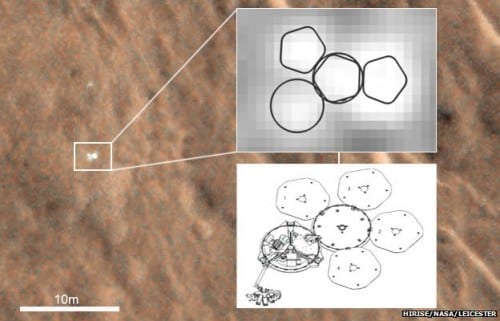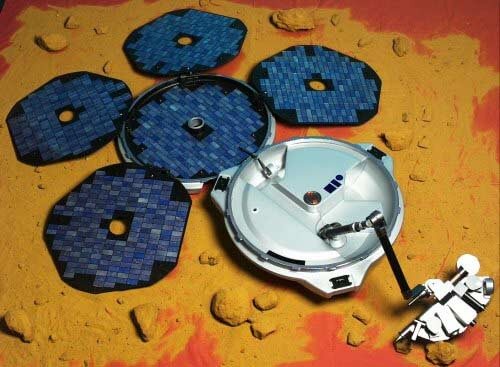High-resolution images taken from orbit around Mars made it possible to identify the location of the landing site of the spacecraft that disappeared on its way to land on Mars in 2003, and it appears that it did not break up

17: 00 Update
High-resolution images taken from orbit around Mars made it possible to identify the location of the landing site, and it appears that it did not disintegrate
The British-built and British-funded European spacecraft attempted a soft landing on the dusty Martian soil on December 25, 2003 using parachutes and airbags, but radio contact was never made.
The assessment was that it disintegrated due to the rapid and uncontrolled landing. The new images taken by the Mars Reconnaissance Orbiter (MRO) disproved this hypothesis and hinted at what happened to the spacecraft.
Although the spaceship is small, polygons were deployed from it during landing, which were coated with solar collectors. However, according to the photographs, it seems that not all of them came out of the box in which they were stored. "Without full deployment there is no way to establish radio communication with the spacecraft because the antenna is below the solar collectors, explains Prof. Mark Sims, director of the Beagle mission at the University of Leicester."
The discovery of the beagle comes less than a year after the death of the spacecraft's principal investigator Colin Pillinger of Britain's Open University, and today the British Royal Society announced awards in his name. Pillinger was the driving force behind the project and although the mission failed to explore Mars it succeeded in generating huge interest in space exploration among the British public.
His widow and research team colleague Dr. Judith Pillinger says that Beagle 2 was born as a result of Colin's search for scientific knowledge. If he were alive today, he would have started a campaign to promote the construction of the Beagle 3 rover, which would continue with experiments that would answer the question of whether life exists or existed in the past on Mars.
For information on the European Space Agency website
For information on the website of the British Space Agency
For information on the NASA website

יThe remains of the British spacecraft Beagle-2 with which contact was lost on Mars in 2003 were found
The news from 16/1/2015 time 00:00
The lander left the same day from the European Mars Express spacecraft, which is still circling and exploring Mars to this day, but disappeared from the radar during its journey to the Idisis plain on Mars, but the exact place of its crash is unknown
A press conference is expected to be held in London today (Friday) in which the British Space Agency will present findings from the HiRise camera images mounted on the American MRO satellite, which apparently contain evidence of the whereabouts of the Beagle-2 spacecraft on December 25, 2003.
The final resting place of Beagle 2 has not been discovered to this day, but scientists operating the HiRise camera, the camera with the highest resolution and the only one that can locate the remains of the lander, have been looking for it for several years.
The HiRise team has already located and photographed from space the pair of Viking landers that landed on Mars in the seventies and photographed the Phoenix spacecraft and the robotic vehicles Curiosity and Opportunity, however the location of these landers was known because they worked well (some still work today) and reported their data to Earth, while the location of Beagle-2 was believed to have disappeared, so it is also difficult to locate it among the millions of HiRise photographs.
Beagle-2, which was built on a tight budget, was supposed to play the opening note of a musical written by the British pop band Bloor. The separation from the Mars Express was smooth and she was placed on the correct course to the plane of Isidis near the equator of Mars, but since then not a single signal has been heard from her, not even the sound of pop music.
More details and photos should be released during the day.
One of the reports on waiting for a signal from the Beagle 2 spacecraft, December 2003 - the Ydan website followed them in real time
Britain's public purse watchdogs are attacking the Mars program following the Beagle 2 crash
The new Beagle will fly to Mars to search for life - The Science, 2002

2 תגובות
Response to response. What is it good for??? It is better to invest in a cure for a.ls or an advanced braking sensor for the car or any real improvement here and now. The space should be left to the truly great ones and our excellent guys will be happy to join the doers in the aforementioned work and see for example Prof. Livio.
It seems that it is not beyond Israel's ability to carry out a task similar to the one the British carried out.